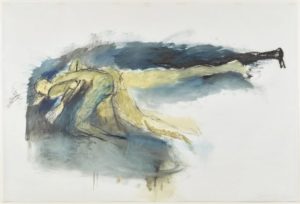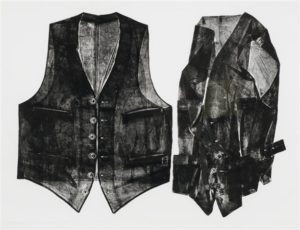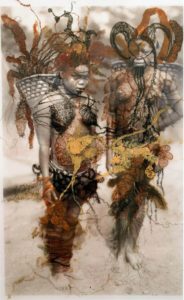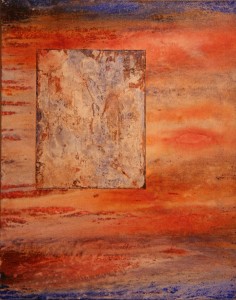Dear Artist,
In the 1960s, when Canadian artist Betty Goodwin was in her 40s, she enrolled in a printmaking class with abstract painter and printmaker Yves Gaucher in Montreal. There, Betty started experimenting with found objects and clothing. Having always collaged on her studio walls as a way of building ideas, it seemed a natural progression to bring these objects — what she called “germs” — directly into her work. While this process brought Betty some positive attention, she felt the work was substandard and destroyed most of it. She then made a commitment to drawing and pursued that direction for several years.
In her 50s, Betty started on a series of monochromatic etchings that used copper plate impressions of distinctly-shaped items including vests, gloves, nightgowns and bulkier items like wrapped parcels and shoes. These prints possessed a kind of melancholy and memory, and had a record-keeping and nomadic quality that seemed to subtly reference her Romanian immigrant parents and her Jewish community in Montreal. Betty straddled printmaking, drawing and sculpture when she elevated waxy, dark tarpaulins into art totems, made figurative paintings on translucent mylar that kept erasures and smudges intact, and painted velvety oils powdered with graphite and charcoal, on paper. Betty’s work, while cool and still, seemed always imbued with a kind of haunting but triumphant survival and life-essence.

Untitled, 1987
Oil, oil stick, iridescent and metallic colour, graphite and charcoal on prepared aluminium composite panel
121.9 × 274.3 × 1 cm
by Betty Roodish Goodwin
When studying her work while still in art school, I noticed that Betty often floated her subjects in space, suspending them like icons, but always leaving some evidence of how she got there. There was a transparent process and playfulness to her otherwise serious vibe. The peak of this deftness is a series of paintings she called Swimmers — adrift and drowning acrobatic tumblers, often irreverently childlike in their positioning and handling. At other times, Betty’s swimmers hovered like corpses. While she seemed to have made no effort to hide their struggle, both in depiction and in their rendering, I always picked up on what I felt was Betty’s own joy when beholding their mystery, endurance and reclamation.
Sincerely,
Sara
PS: “Drawing is the most inalienable medium. It is private; it practically doesn’t have an audience in mind, just the artist’s expression.” (Betty Goodwin)
Esoterica: Interdisciplinary American artist Kenyatta A.C. Hinkle also uses an objects-based approach when collaging, drawing and painting using historical photographs. When preparing for her 2019 SFMOMA SECA Award exhibition, Kenyatta said that while she felt it sort of taboo to say so, tapping into her intuition to make art was a way to access her culture by letting its objects speak for themselves. In this way, and like the materiality of Betty’s prints and tarps and drawings, the work begins with its vibe and energy and the history of the objects used, and finishes with its fabrication into art. “I don’t know what this work is going to look like, but I know what it’s going to feel like,” said Kenyatta, about her show. “I know what I want people to feel when they go into that space…and then it’s just a matter of finding that visual language.”
Have you considered a Premium Artist Listing? With each letter, an artist is featured at the bottom of this page. The Premium Artist Listings are a means of connecting artist subscribers through their work. Proceeds from each listing contribute to the production of The Painter’s Keys.
“A culture can never be truly erased. There is always some type of residue, the way you dream, the way you walk.” (Kenyatta A.C. Hinkle)
Featured Artist
Painting is my passion and joy. My process is intuitive, though informed by good composition and design principles. I paint what I remember, or think about, or feel, or just what comes off my hands to the brush to the canvas. Texture and color are of primary importance to me. I typically choose my support, texture it, select my palette, and go. There is nothing more satisfying to me than watching paint run and move. I love the surprises. I experiment and learn constantly. It is a remarkable journey. One I am pleased to share with you.







6 Comments
Nice. If I was to say something about her figures it has them floating in water, some more than others. In a short search I really liked her self portrait from the mid 40s. Everything is very secure and certain in the way she described the uncertainty of place. Thanks, Sara
Betty Goodwin is one of my favourite artists — thank you for highlighting her work.
Oh! Thanks for sparking a memory. Years ago on a visit to Montreal, I stumbled on an exhibit of this artist’s work. Her ghostly images made the lives of immigrants long gone seem so real and present.
MapQuest Directions provides accurate and up-to-date navigation for all your travel needs. Whether you’re driving, walking, or taking public transit, MapQuest ensures you get to your destination efficiently and safely.
The level editor transforms Geometry Dash from a simple platformer into a limitless creative tool. Players build environments, sync every obstacle to music, and design artistic effects
Thanks for sparking a memory. Years ago on a visit to Montreal, I stumbled on an exhibit of this artist’s work.